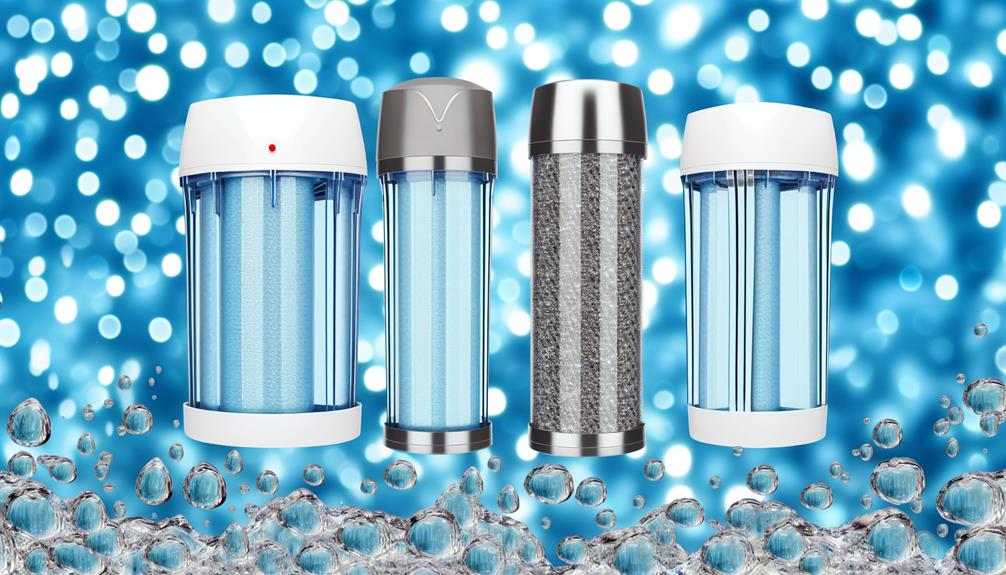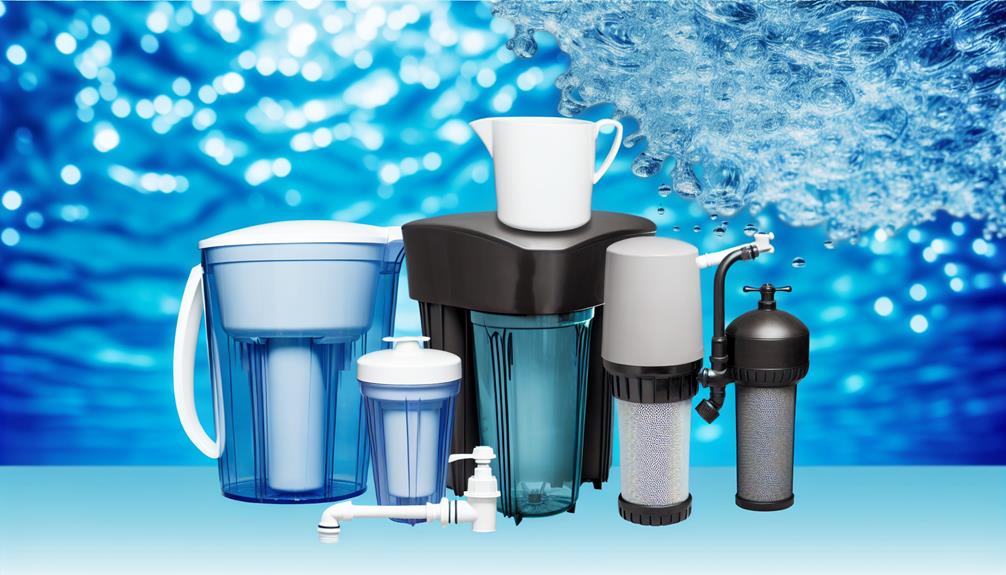Just as you turn on your tap for a glass of water, it's worth reflecting on how far we've come in ensuring that water's purity.
You see, the journey from the murky waters of ancient civilizations to the crystal-clear glass you hold today is marked by centuries of innovation. Sand and gravel, once at the forefront of filtration, have given way to complex methods like reverse osmosis and UV disinfection, each step driven by the quest to remove not just visible impurities, but the myriad of chemicals that pose unseen threats.
As a professional in the field, you'll appreciate the nuanced advancements and the subtle dance of chemistry and engineering that have shaped modern water filters.
Yet, as you stand here, glass in hand, questions linger about the future of our water's safety and the next chapter in the evolution of these vital technologies. What new challenges will they address, and how will they transform our relationship with one of life's most essential elements?
Ancient Filtration Methods
Delving into ancient filtration methods, it's evident that civilizations like the Egyptians and Mayans developed sophisticated techniques, such as sand and gravel filtration, to enhance water quality. In ancient times, the practice of water purification wasn't merely functional; it was an art finely tuned with the available natural resources and empirical knowledge.
The ancient Egyptians, known for their ingenuity, harnessed the process of coagulation to remove unwanted particles from water, a method indicative of an advanced understanding of water treatment technology.
The ancient Greeks contributed significantly to these early endeavors. The Hippocratic sleeve, a cloth bag designed by Hippocrates, served as a rudimentary filter to improve water's taste and reduce its cloudiness. This innovation reflects the Greeks' dedication to health and the environment, paralleling the analytical rigor applied in contemporary water treatment research.
Furthermore, ancient texts, including those in Ancient Greek and Sanskrit, provide documentation of various water purification practices. These include not just the use of a sand filtration system, but also boiling and exposure to sunlight. Such methods underscore the early recognition of the sun's ultraviolet properties and the efficacy of using sand as a natural filter medium.
Sir Francis Bacon, much later, would experiment upon these ancient techniques, laying a foundation for modern water purification systems.
Sand Filters Development
Building on the groundwork of ancient purification techniques, the development of sand filters marked a significant evolution in water treatment, with the first known municipal implementation appearing in Scotland in 1804. The use of sand and gravel in these early filtration systems was a pivotal step in refining the process to remove impurities effectively.
Sand filters development can be categorized into two primary types: slow sand filtration and rapid sand filtration. Each type was designed with specific objectives in mind.
Slow sand filtration, introduced in the United States around 1870, operates at lower flow rates and uses finer sand to achieve a high level of purification by removing disease-causing organisms.
On the other hand, rapid sand filtration processes water at a faster rate using coarser sand and requires frequent cleaning, typically through backwashing.
Here are key differences between the two:
- Flow rate: Slow sand filters have a lower flow rate compared to rapid sand filters.
- Grain size: Fine sand is used for slow filtration, while rapid filtration uses coarser grains.
- Maintenance: Slow sand filtration systems require less frequent maintenance than rapid sand filtration systems.
Filtration systems are designed to leverage the natural filtration capabilities of sand, a practice rooted in ancient methods. Water filtration experiments continue to refine these systems, ensuring their relevance and efficacy in modern water treatment protocols.
Rise of Activated Carbon
Activated carbon filtration represents a significant leap forward in water purification technology. It relies on the adsorptive capacity of activated carbon to effectively remove a wide range of organic contaminants and improve the sensory qualities of drinking water. As you investigate the evolution of filtration technologies, it's crucial to understand the pivotal role activated carbon plays in promoting chemical safety within water treatment systems.
The unique property of activated carbon is its expansive surface area, produced during the activation process, which is primed for adsorption. This allows it to trap and remove contaminants, such as manufactured pollutants like pesticides, which pose significant health risks. Municipal water filters, increasingly incorporating activated carbon, address the growing concerns over these hazardous substances.
Moreover, the filtration prowess of activated carbon extends to the abatement of heavy metals and the neutralization of water chlorination by-products, which can lead to carcinogenic compounds if left untreated. The integration of activated carbon in household and municipal water purification systems is a testament to its efficiency and versatility.
As you delve deeper into water treatment methodologies, remember that activated carbon is more than a filter medium—it's a guardian of public health, tirelessly working to ensure the water you consume is free of detrimental chemicals and aesthetically pleasing.
Advancements in Reverse Osmosis
Nearly all impurities can be eliminated from your water supply with the introduction of reverse osmosis technology, which utilizes a semi-permeable membrane to purify water at a molecular level. Since its inception in the 1980s, reverse osmosis systems have become integral to modern water filtration systems, both at the municipal water treatment plant level and for domestic use.
The first membranes for reverse osmosis were effective, yet modern advancements have dramatically improved their efficiency and reliability. These membranes for reverse osmosis are now capable of removing up to 99.9% of contaminants, including those responsible for waterborne diseases. The impact on water quality is substantial, ensuring compliance with the Safe Drinking Water Act and other regulatory standards.
Consider the following advancements in reverse osmosis filter technology:
- Enhanced Membrane Materials: Newer materials provide greater durability and resistance to chemical degradation, extending the life of the reverse osmosis systems.
- Improved Energy Efficiency: Advances in system design have reduced the energy requirements, making reverse osmosis more sustainable and cost-effective.
- Nanotechnology Integration: The incorporation of nanotechnology has led to the development of more selective and permeable membranes, further improving the filtration performance.
As you delve deeper into the evolution of water treatment, it's clear that reverse osmosis remains a cornerstone of ensuring chemical safety in drinking water.
Innovations in UV Purification
While reverse osmosis systems have set a high standard for removing impurities, innovations in UV purification offer a complementary solution that targets and eradicates microorganisms without the use of chemicals. UV purification stands as a pivotal technology in water treatment, ensuring the safety of drinking water by utilizing ultraviolet light to neutralize harmful pathogens, thus safeguarding public health.
You'll find UV purification integral to the modern framework of water filter systems, designed to address waterborne illnesses effectively. Its capacity to disrupt the DNA of microorganisms aligns with the germ theory of disease, preventing the spread of water contamination without introducing foreign substances into the water supply.
Recent advances have scaled down UV purification technology for not just residential and commercial use but also for portable applications. These compact, energy-efficient devices ensure that you can maintain water quality consistently, even when on the move. They exemplify the evolution of water standards, delivering a high level of protection in a variety of settings.
As you evaluate water filter systems, consider how UV purification complements traditional methods, enhancing your defense against the invisible threats lurking in unfiltered water. It's a testament to the ongoing innovation committed to preserving the purity and safety of our most vital resource.

